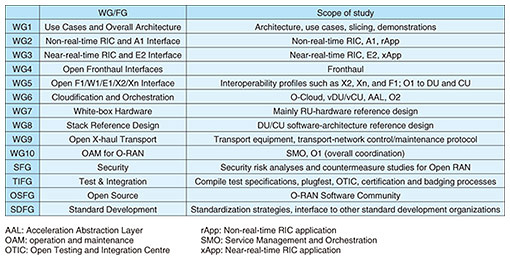 |
|||||||||||||||||||||||||||||||
|
|
|||||||||||||||||||||||||||||||
|
Feature Articles: Toward Open and Intelligent Wireless Networks Vol. 20, No. 11, pp. 46–51, Nov. 2022. https://doi.org/10.53829/ntr202211fa6 Initiatives toward Open RANAbstractThe fifth-generation mobile communications system (5G) network will need to support a wide range of services compared with past networks. To meet this need, it will be necessary to construct a flexible network that can accommodate all types of services. The Open Radio Access Network (RAN) can make this a reality. This article provides an overview of Open RAN, presents the current state of the O-RAN ALLIANCE that promotes Open RAN standards, and describes the 5G Open RAN Ecosystem, a new NTT DOCOMO Open RAN initiative. Keywords: vRAN, virtualization, Open RAN 1. IntroductionTo respond in a more suitable manner to customer needs, all mobile operators are required to add new network equipment and replace equipment to expand network functions on a continual basis. The network will therefore have to be capable of such scalability in a flexible and agile manner. To this end, NTT DOCOMO has been promoting open interfaces that will enable operators to freely select and adopt optimal solutions from a variety of vendor products. This article provides an overview of the Open Radio Access Network (RAN)*1 and touches on the current state of the O-RAN ALLIANCE. It also describes the 5G (fifth-generation mobile communications system) Open RAN Ecosystem launched by NTT DOCOMO to globally accelerate Open RAN and the approach that it takes to solve problems related to performance, integration*2, and interoperability testing in Open RAN.
2. Open RAN2.1 Three elements of Open RANOpen RAN consists of the following three elements (Fig. 1): (1) Open interfaces that combine RAN equipment from a variety of vendors (2) Virtualization (i.e., virtualized RAN (vRAN)) that enables hardware and software inside RAN equipment to be separated (3) Intelligent control that optimizes and automates RAN operation
2.2 Effects of Open RANThe base-station components for Open RAN can be separated into three units—radio unit (RU)*3, distributed unit (DU)*4, and central unit (CU)*5—each of which can be connected via standardized interfaces. This means that telecom operators can free themselves from vendor lock-in, shorten the time to commercial deployment, and adopt a better equipment configuration to provide optimized services to consumers. The virtualization of a RAN means that costs can be decreased through the use of general-purpose hardware and that flexibility and scalability can be enhanced. Envisioning an increasingly complex mobile network, manual operation of the network as has been the practice will become all the more difficult, but this problem can be solved through the intelligent control of a RAN. 3. Current status of Open RAN standardizationIn February 2018, NTT DOCOMO joined with other industry operators to establish the O-RAN ALLIANCE with the aim of promoting open and intelligent RANs [1]. We introduce new initiatives of this organization from 2019 to the present. There were 19 operators and 55 vendors and institutions serving as members of the O-RAN ALLIANCE in 2019, but this has expanded to 31 operators and 294 vendors and institutions as of February 22, 2022. While only fronthaul*6 specifications from Work Group 4 (WG4) had been released in 2019, new specifications had been released from each WG and Focus Group (FG) as of February 22, 2022. We introduce newly released specifications from WG4 and WG5 for which NTT DOCOMO has been serving as co-chair. In WG4, in addition to fronthaul specifications consisting of the control, user and synchronization plane (CUS-Plane) and management plane (M-Plane), the following three types of specifications have been released with version upgrades already being made. Test specifications:
Cooperative transport interface (CTI) specifications:
In constructing Open RAN, testing must be conducted to confirm whether equipment from different vendors conforms to the interface specifications of the O-RAN ALLIANCE and whether multi-vendor connections can be made. In WG5, the following specifications were released with version upgrades being made. X2*7 specifications:
Transmission path specifications:
Monitoring control specifications:
IOT specifications:
To make intelligent Open RAN a reality, a number of new WGs and FGs have been established. Table 1 summarizes the WG/FG activities.
The WGs and FGs that have been added since the founding of the O-RAN ALLIANCE in 2018 are WG9, WG10, Security FG (SFG), Test & Integration FG (TIFG), Open Source FG (OSFG), and Standard Development FG (SDFG). Security concerns, in particular, have been raised as a key issue in Open RAN, and at the O-RAN ALLIANCE, SFG is conducting security risk analyses and countermeasure studies.
4. NTT DOCOMO Open RAN initiatives4.1 NTT DOCOMO multi-vendor network initiativeIn conventional networks, a single vendor provides base stations for both baseband signal processing units (BBUs) and RUs in a single-vendor configuration. One advantage of having a single vendor is that the operator can rely on that vendor for a range of services from deployment to maintenance in a one-stop manner. Since the interfaces between equipment are vendor-proprietary interfaces, a disadvantage is that the operator cannot upgrade to equipment from other vendors, decreasing flexibility. NTT DOCOMO took the lead in achieving a multi-vendor network before the coming of 5G. Specifically, NTT DOCOMO enabled connections between different vendors by prescribing original interfaces between the BBU and RU, achieving a flexible base-station configuration (Fig. 2). Since there were now multiple options for selecting base-station-equipment vendors, it became possible to select the most optimal vendors in terms of cost and performance, lowering the cost of deploying equipment.
4.2 NTT DOCOMO Open RAN initiatives in 5GWhen launching 5G commercial services in 2020, NTT DOCOMO was the first in the world to achieve Open RAN in a commercial network using interfaces conforming to O-RAN ALLIANCE standards. All 5G base stations that NTT DOCOMO is now rolling out conform to O-RAN ALLIANCE fronthaul and X2 specifications. Since this is Open RAN, NTT DOCOMO has been gradually expanding equipment vendors and the variation in equipment ever since the 5G pre-commercial service period. Specifically, NTT DOCOMO has come to support millimeter-wave (mmW)*9 capabilities, sub-6*10 inter-band carrier aggregation (CA)*11, and stand-alone (SA)*12 operation. While only small RUs (SRUs) for small-cell use of both the antenna-separated and antenna-integrated types were deployed at the launch of 5G commercial services, NTT DOCOMO has since expanded the equipment lineup to include regular power RUs (RRUs) for macrocell use and 5G fronthaul multiplexers (FHMs)*13. NTT DOCOMO is therefore adopting new vendors for CU/DU and RU. NTT DOCOMO considers its multi-vendor initiative between equipment through open interfaces that it has been implementing as being its first step in Open RAN deployment. As the next step, it will promote studies on achieving the remaining two elements of Open RAN described above, i.e., virtualization and intelligent control (Fig. 3). This will be achieved through NTT DOCOMO’s 5G Open RAN Ecosystem initiative described in the next section.
5. Promoting Open RAN across the globe5.1 Founding of 5G Open RAN EcosystemIn February 2021, NTT DOCOMO established the 5G Open RAN Ecosystem together with 12 other companies with the aim of accelerating the adoption of Open RAN by operators. Through this ecosystem, NTT DOCOMO aims to accelerate vRAN testing. It also intends to make state-of-the-art RAN into a commercial package based on the requirements of mobile operators that are studying the introduction of Open RAN and to offer Open RAN deployment, operation, and maintenance services. By making use of the Open RAN knowledge it has built up over many years, NTT DOCOMO will work to promote the 5G Open RAN Ecosystem and provide high-quality and flexible networks. 5.2 Open RAN problems and solutionsAs described above, Open RAN has advantages but also has a number of problems that must be solved. We give an overview of the main problems in deploying Open RAN and describe how the 5G Open RAN Ecosystem plans to solve these problems. (1) Performance In vRAN, one of the elements of Open RAN, general-purpose servers are used as hardware, but when running RAN applications on such servers, radio characteristics, accommodation capacity, etc. may deteriorate. As a solution to this problem, end-to-end (E2E) vRAN testing using an accelerator is being promoted within the 5G Open RAN Ecosystem to achieve performance 2–3 times that of current performance. The 5G Open RAN Ecosystem Whitepaper including these performance targets was released in June 2021, so we ask the reader to refer to that material as well [2]. (2) Integration In Open RAN, base-station components can be separated, but an issue that arises is how to integrate those components. In vRAN, hardware and software can be separated, so it is believed that components from different vendors can be integrated and provided accordingly. In this case, the number of interfaces needed for integration increases compared with conventional RAN. As a solution to this problem, an Open RAN testing environment, which is described in the next section, is being set up within the 5G Open RAN Ecosystem to provide multi-vendor integration testing to overseas operators who are testing and operating RAN. (3) Other issues Costs, automation, and equipment rollout are also problems in Open RAN, and NTT DOCOMO solutions to these problems are described in other feature articles in this issue [3, 4]. 5.3 Sharing of Open RAN testing environmentAs described above, using multi-vendor products means that products must be appropriately selected and integration testing conducted. However, test cases increase as the number of products and interfaces increases, and having each operator prepare an environment tailored to its testing needs is inefficient. Against the above background, NTT DOCOMO set up an open testbed in Japan as part of the 5G Open RAN Ecosystem. One of the main functions of this testbed is enabling overseas mobile operators to remotely control it as if it was a testbed in their own laboratories. This testbed can be connected to an operator’s core network*14, making it easy to conduct tests of vRAN equipment using products from multiple vendors. Thus, an operator can dramatically decrease the time and costs incurred by testing, so it is thought that this testbed can contribute to the timely deployment of Open RAN. The testbed began operation in summer 2021. Products from 5G Open RAN Ecosystem partners have been provided since October 2021 and testing has begun. This testbed was released in February 2022 as a shared open laboratory providing an environment for operators around the world to test vRAN while based overseas. NTT DOCOMO is using this shared open laboratory to deepen its ties with a wide range of stakeholders including other operators and to contribute to the establishment of technologies and expertise toward the early diffusion of an open network, especially Open RAN and vRAN, that can respond flexibly and rapidly to diverse needs.
6. ConclusionThis article presented an overview of Open RAN, described the current state of the O-RAN ALLIANCE that is responsible for Open RAN standardization, and described the 5G Open RAN Ecosystem, a new NTT DOCOMO Open RAN initiative. As an Open RAN pioneer, NTT DOCOMO will continue to promote Open RAN that should be implemented for its own network as well as globally. References
Trademark notesAll company names or names of products, software, and services appearing in this article are trademarks or registered trademarks of their respective owners. |
|||||||||||||||||||||||||||||||
















